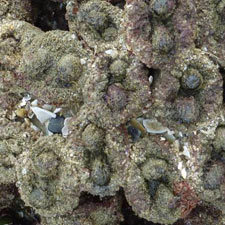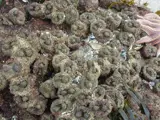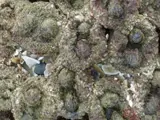 Pyura
Pyura
Common name: Pyura
Botanical name: Pyuridae – Pyura praeputialis
Management programme: Exclusion
Where is it originally from?
Pyura originates in South America and is likely to have arrived in New Zealand as an unwanted hitchhiker on a vessel, either as larvae held in ballast water or as hull fouling.
Why is it a pest?
- The Pyura sea squirt is an aggressive competitor for space and has the potential to significantly alter the structure and composition of intertidal communities.
- It can drastically alter habitats by overgrowing other marine invertebrates.
- Its impact in the New Zealand environment is not yet known. There is concern that, should it spread, it could displace important native species, including green-lipped mussels. There are also concerns Pyura could be inadvertently spread to marine farms outside the Far North region (NIWA, 2016).
Where is it found?
- Dense mats have already engulfed and displaced native green-lipped mussel beds in some areas of the Far North.
- Pyura is generally found in the intertidal habitat less than 12m deep, attaching to hard platforms. It appears to prefer rocky coastlines.
- Populations can possibly survive in most coastal regions of the North Island as well as the top of the South Island.
- Populations are likely to only spread short distances through natural dispersal alone.
- There is also potential for spread through hull fouling and the transfer of aquaculture stock and equipment.
- Pyura is not known to be found in the Bay of Plenty as at 2020.
What does it look like?
- Sea squirt up to 60mm long and 30-50mm in diameter.
- The body is tough and covered with sand and algal filaments, appearing green and sandy.
- When out of the water, two large mounds indicate the location of the siphons.
- Other sea life such as sea lettuce can grow on and around them.
- When submerged, siphons are visible and a bright reddish orange.
- Pyura sea squirts are hermaphrodites and are believed to self-fertilize.
What are the rules?
Exclusion
Exclusion pests are not known to be present in the Bay of Plenty region. The Bay of Plenty Regional Council is responsible for managing new incursions into the region. Action may be required from landowners or occupiers to support a control operation.
What are the rules around keeping boat hulls clean and transporting of marine pests?
- Keep your boat bottom and any niche areas clean (no more than light slime, all the time).
- Keep your anti-fouling paint fresh - manufacturers usually recommend replacement every 1-2 years.
- Check your hull before you travel to a new area, every time.
- If your boat is heavily fouled, haul it out. Cleaning underwater will only spread any pests that may be hiding on there.
To prevent the spread of marine pests, Bay of Plenty marinas require visiting vessels to have been recently cleaned. That means:
- Antifouled in the last six months.
- Lifted and washed in the last month.
Check with the marina what proof is required. Some high-risk vessels may be subject to additional marina requirements.
Tauranga marinas have their own hull hygiene rules for visiting vessels. Plan ahead - contact Tauranga Bridge Marina on 07 575 8264 or Tauranga Marina on 07 578 8747 for details.
How do you get rid of it?
If you find Pyura please do not attempt to control it. Please contact the Bay of Plenty Regional Council on 0800 STOP PESTS (0800 786 773).
Images


